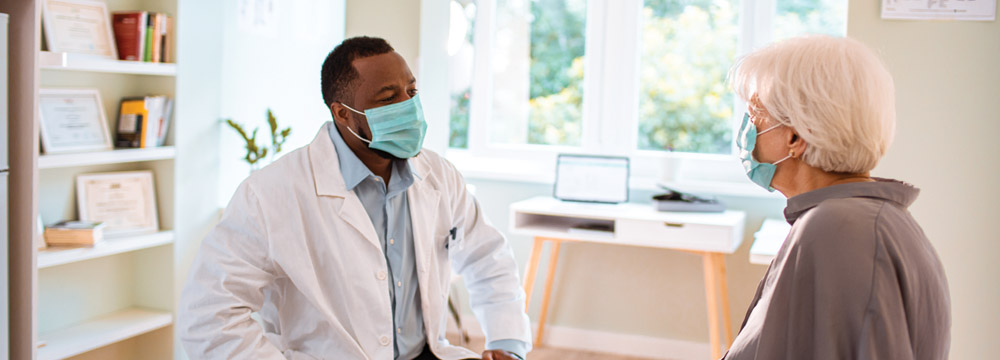
Preventive care still on during COVID-19
COVID-19 may foster innovation in primary care as physicians describe various strategies to reconnect with patients, such as leveraging telemedicine visits to also explain the practice's coronavirus-related safety protocols, or systematically reviewing their panels to flag at-risk patients.
While office visits and preventive care, including cancer screenings, plummeted during the early months of the pandemic, data indicate that patients have been returning for more routine visits since summer. But as the novel coronavirus continues to circulate, there's an accruing backlog of necessary care.
For physicians, this raises multiple concerns. What diagnoses are being missed? Which chronic conditions remain poorly managed? How are they going to reach those medically vulnerable patients who are still reluctant to cross their office thresholds?
“The people who are coming in for preventive concerns are self-selected and have always placed a high priority on their preventive care,” said Heather E. Gantzer, MD, MACP, who chairs ACP's Board of Regents. “But for the people for whom it's not part of their life routine, and part of their high priority, often they're falling off the radar screen and they don't come in.”
Outpatient office visits, which had declined by nearly 60% as of early April, had returned to about 10% below prepandemic levels by mid-June through late July, according to an analysis of more than 50,000 clinicians published in mid-August by Harvard University researchers, the health technology company Phreesia, and the Commonwealth Fund. Another analysis involving data from the health technology company Epic found that breast, cervical, and colon cancer screenings, which had dropped by as much as 94% initially, still hovered roughly two-thirds below typical levels as of mid-June.
Physicians described various strategies they've been using to reconnect with patients, such as taking advantage of prescription refill requests to schedule overdue preventive care. They talked about leveraging telemedicine visits to also explain the practice's coronavirus-related safety protocols, as well as more systematically reviewing their panels to flag at-risk patients who should be contacted via phone call or text message.
Depending upon how reimbursement for telemedicine and other aspects of primary care sorts out in the months to come, this COVID-19 era may foster further innovation to better treat underserved patients who have always struggled to get routine care, said Daniel Horn, MD, a general internist and director of population health for the division of general internal medicine at Boston's Massachusetts General Hospital.
“I do believe that for a lot of health systems and for a lot of health care professionals, these known and widely published disparities in health in the United States have been crystalized through the process of the pandemic,” said Dr. Horn, who coauthored a related perspective piece published Aug. 12 by the New England Journal of Medicine. “I can't imagine that there won't be change coming out of this.”
Prevention backlog
Already, research shows that bypassing preventive care could have some longer-term implications. One analysis looking at weekly diagnoses for six types of malignancies in the early days of the pandemic, March 1 to April 18, found that they had declined overall by 46.4% compared with Jan. 6, 2019, through Feb. 29, 2020. That decline ranged from nearly 25% for pancreatic cancer to nearly 52% for breast cancer, according to the findings, published Aug. 4 by JAMA Network Open.
Along with not getting recommended vaccines and screenings, some patients may be going without ongoing care for high blood pressure, diabetes, and other chronic diseases, said Ateev Mehrotra, MD, MPH, a hospitalist at Beth Israel Deaconess Medical Center and lead author on the Commonwealth Fund analysis of outpatient visits. But trends don't reveal what type of care is being missed and whether its loss is worrisome, he said.
For instance, were quarantined patients still taking their medication and keeping in touch with their doctor by phone or patient portal? If so, skipping a checkup in the short term may not present a significant risk, Dr. Mehrotra said.
“When you see a 60% decline in visits, I feel confident that many of those visits were required and probably missing them led to harm,” said Dr. Mehrotra, an associate professor of health care policy and medicine at Harvard Medical School. “Now that we're at about a 10% visit decline overall across all patient groups, then you can start asking the question, ‘How much of that visit decline is due to necessary versus unnecessary visits?’”
Meanwhile, some medical issues have been on the upswing, most notably behavioral symptoms. During a two-week period starting March 31, nearly 28% of U.S. adults reported depressive symptoms versus 8.5% before the pandemic, according to findings published Sept. 2 by JAMA Network Open. Individuals with less than $5,000 in savings were twice as likely to report symptoms.
Those rates exceeded depressive symptoms seen after traumatic but more time-limited events such as the Sept. 11 terrorist attacks, said the study's lead author Catherine Ettman, BA, director of strategic initiatives at Boston University School of Public Health and a doctoral student at Brown University School of Public Health in Providence, R.I. The pandemic is not only ongoing but more than a single event, she said. “This is both COVID and the fear and anxiety around COVID, as well as the dramatic economic consequences.”
Also, people struggling with depression or anxiety may skimp on medical care, according to another recent study, published Sept. 1 by the Journal of General Internal Medicine (JGIM). Among those individuals surveyed in June, nearly one-third said they didn't get noncoronavirus medical care that they needed during the prior four weeks. The likelihood of avoiding care was up to twice as high among those who reported at least one of four common symptoms of depression or anxiety during the prior seven days.
Reconnecting with patients
Sheri Weiser, MD, MPH, an author of the JGIM study, was not surprised that mental health strain and care avoidance proved to be intertwined. Dr. Weiser, a general internist who treats HIV patients at Zuckerberg San Francisco General Hospital, said it became apparent early in the pandemic that the myriad stressors—not just the virus, but also economic turmoil and structural racism—were leading some patients to skip care or fall off their drug regimen.
As a result, she and her colleagues began asking their HIV patients to get their viral loads checked every three months instead of every six months to gain a better sense of treatment adherence, said Dr. Weiser, who is also a professor of medicine at the University of California, San Francisco. Plus, Dr. Weiser said that she and other clinicians touched base with patients in the early days of the pandemic, checking on their mental health and access to food and basic needs, among other issues.
“For a substantial number of my patients, myself and our clinic could be the main social external connection point, as some people are quite isolated,” she said. “COVID was an incredibly stressful life-changing event for everybody, and if you don't have a social support network that much more so.”
Another way to reestablish contact with a patient, Dr. Gantzer said, is when they need a prescription refill. When she receives a request, she'll check when the patient last had an appointment and whether he or she is behind on any preventive care. For instance, if the patient required a Pap smear and a blood pressure follow-up visit, she'd likely fill the prescription but alert the patient to schedule an in-person visit prior to the next refill.
If the patient is caught up on preventive care, that next visit may be handled through telemedicine, Dr. Gantzer said. If the reimbursement for telemedicine continues to be similar to in-person care, she said, virtual visits provide a great alternative depending on the patient's medical needs and personal preferences.
But don't discount the payoff of a periodic in-person visit, as it extends beyond listening to a heart murmur or checking on vitals, Dr. Gantzer said. “I think one of the key values of the office visit is the relationship and building trust, whether that's for 31 years or seeing someone for the first time.”
For those patients who remain reluctant to darken the practice door due to viral fears, a telemedicine visit also can provide a useful bridge, said Lisa Ravindra, MD, FACP, an assistant professor of general internal medicine at Rush University Medical Center in Chicago.
“If it's something that I then need to have them come in for,” she said, “I can at least talk to them and tell them what we're doing in the office to keep them safe.”
Recalibrating care
To reach at-risk patients who are still avoiding care, primary care practices will need to assume a more population health mindset if they haven't already, Dr. Mehrotra said. “In some ways primary care sometimes can be a bit passive,” he said, noting that when patients are asked to return for a follow-up visit in a few months, the practice doesn't necessarily backtrack to see if they did.
Moreover, mammograms, colonoscopies, and other cancer screenings that could be delayed initially for a few months can't continue to be pushed back as the pandemic persists, Dr. Mehrotra said. “If we miss a full year of those kinds of screenings, that could have harm.”
This pandemic stretch does provide an opportunity for further innovation in primary care, as physicians learn not just to incorporate more telemedicine into their daily practices, but also better use of patient registries and potentially community navigators and other strategies, Drs. Mehrotra and Horn said.
Ideally, if patients have difficulty coming to the office regularly due to age or other logistics, a physician could order a peak flow meter, a telemedicine-compatible stethoscope, and other monitoring devices for the home, similar to ordering equipment like a bedside commode, Dr. Mehrotra said. With more such equipment handy, a video visit could be as productive as possible, he said, adding that reimbursement would need to catch up.
In his recent NEJM perspective piece, Dr. Horn took that outreach approach a step further, raising the possibility that primary care's future could include mailed prevention kits with colon cancer screening, lipid testing, and other home tests inside. Those tests could be paired with electronic questionnaires to screen for other issues, including substance abuse and depression. Community navigators could provide support and education and accompany patients to procedures, such as colonoscopies, he wrote.
With the data in hand, the physician could discuss the results and related decisions with the patient, whether in person or via telemedicine, Dr. Horn said, “instead of using annual visits as the mechanism by which many of those preventive services are initiated and then scheduled. Which means that only patients that have these annual visits end up getting a lot of these preventive services—that's the rub.”
Primary care's reimbursement model would have to change to support this type of framework, as there's no mechanism to bill directly for navigator support or prevention kits, Dr. Horn said. But Dr. Mehrotra believes that primary care physicians may be more interested in moving away from fee-for-service reimbursement to a payment approach tied to caring for a group of patients, after watching their income abruptly slide during the pandemic's early days.
As the pandemic stretches on into winter, influenza cases and other respiratory miseries are arriving day by day, along with more COVID-19 cases. In this environment, physicians will have to continue to make their case for prevention and other routine care, Dr. Weiser said. Along with educating patients about the setup of their socially distanced waiting rooms and other protective practices, physicians also should talk frankly about relative risk, she said.
“[C]larify that the risks of not going [to the doctor's office] are much higher than the risks of going,” Dr. Weiser said. “Your very, very small risk of getting COVID is much lower than your actually quite high risk of having a heart attack, if you have significant heart disease and you're not coming in.”



